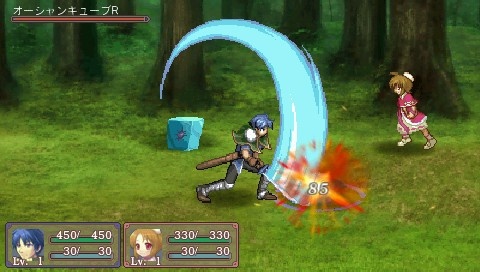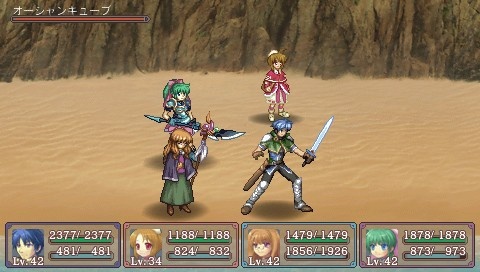There are some games that, even with a layer of glitter dusted over the top, simply can't hide the slapdash, unrefined nature that lies beneath. Instances of aesthetic competence give way to confusing level design; promises of action-packed combat go unfulfilled as you're mired in listless, tired sword swinging. Mimana Iyar Chronicles, a shoddy action-RPG for the PSP, is one such unfortunate example that elicits equal parts boredom and frustration.
What's perhaps the most surprising thing about Mimana Iyar Chronicles is that it begins decently enough. The game greets you with a well-drawn anime cutscene with serviceable voice acting. Quickly thereafter you're introduced to your protagonist, Crais, a member of the mercenary's guild with a gambling itch and an attitude problem. A fellow guild member pulls you away from a hopeless game of cards and takes you to a little girl, Sophie, who has hired you to be her bodyguard as she sets about collecting a set of mysterious gems. The art is well drawn if a bit generic, and the music shows off some pleasant instrumentation. Because you're free to explore the decently sized town with its bright colors, crisp lines, and denizens who hint at an expansive world beyond its walls, it seems like you're heading off on a grand--or at least decent--adventure.

Soon after the opening minutes, however, Mimana starts to grate. Crais apparently has a problem with little kids and isn't at all shy about sharing this fact. For the first handful of hours of gameplay, almost every instance of dialogue is laced with some backhanded comment about how Crais can't stand being around Sophie because of her age. "I told you, I hate kids." "This is why I can't stand being around kids." "Hey kid! Move it! You're holding us up. You're such an idiot!" The first time you hear it, it's actually a bit bold and somewhat refreshing. There's definitely a sad story behind Crais' bitterness, too. But early on, it's reinforced through so much blunt repetition that you'll want to skip all the dialogue long before you find out why he has turned out this way or to witness his cliched (and almost abrupt) change of heart.
In fact, the other party members (all female) you meet along the way are presented this way: Show players a defining character trait that is initially humorous, and then repeat it through dialogue mercilessly until it becomes absolutely grating. There's the deranged sorceress who wants to disrobe and dissect everyone around her in the name of science, and the warrior who wants Crais to marry her because he accidentally happened upon her bathing in a lake and she took offense. Then there's the homunculus--a human body who exists for the sole purpose of serving a master--who can't understand music or beauty because she doesn't possess a soul. For the better part of their involvement with your party, these characters barely develop, if at all, past their designated shtick.
The mishandling of the characters wouldn't be so objectionable if the rest of the game made up for it, but this isn't the case. For the most part, you travel back and forth between a central hub town and its surrounding dungeons, which feel like they were designed two decades ago--and not in that feel-good, old-school way. Instead, you'll be frustrated by dead ends; forks in roads that serve no purpose other than to confuse; corridors and paths that look exactly like those you traversed just minutes prior; and a static camera that's zoomed in a little too much to give you a good view of what lies ahead and behind you. One late-game dungeon has you following long, winding walkways (complete with one-way teleporters) just to push a switch and backtrack so that you can do it three more times. Not all role-playing games need to have a mapping system, but given its loopy labyrinths, this one desperately does.
Mimana Iyar Chronicles also needed some modicum of excitement in its battle system. Mimana gives you real-time, hack-and-slash control over Crais, so you spend most of your time button-mashing to defeat your foes as opposed to digging through menus. Though this sounds reminiscent of the dynamic battle systems found in Star Ocean: The Second Story or Valkyrie Profile: Lenneth, the slow-footed Crais comes armed with a single clumsy three-hit combo (which looks like it's animated with three stiff frames per strike). He'll be fighting equally slow-footed and clumsy enemies who aren't hard to hit. Every battle takes place in the same rectangular arena, dressed up in different, ugly backgrounds depending on the dungeon, and you can't directly control anyone other than Crais.

Because of this, fighting is an absolute bore. Hopping into menus is an option if you want to cast healing, attack, buff, and debuff spells with the other characters, but the majority of spells take long enough to cast that you're better off leaving the rest of your party to the artificial intelligence--boneheaded as it may be. (Don't be surprised if an AI-controlled character absorbs a few hits before deciding to move out of the way.) While the game is challenging at times, this is due only to how hard enemies hit and how much punishment they can take. Otherwise, from a tactical and skill-based perspective, the game is brain-dead. At least the enemies are eccentric. There's some minimal entertainment to be had from facing off against floating gems, humongous sheep, a giant enemy crab, and a beetle-type creature with the perplexing name "cockasusgadore."
Whether it's the obnoxious dialogue, clunky battles, or archaic dungeon design, within an hour Mimana Iyar Chronicles will make you forget about any promise you saw early on. The plot stays stagnant for a good three-quarters of the 15 to 20 hours it will take you to complete the experience, and even if you take advantage of the optional side quests near the endgame, what payoff there is isn't worth the early mental hassle. Spare yourself the tedium; slaying a cockasusgadore is an overrated experience anyway.